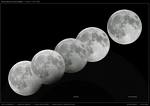An eclipse of the Moon also called the lunar eclipse occurs only at Full Moon. Also the Moon should pass through some portion of Earth's shadow. That shadow is actually composed of two cone-shaped components, one nested inside the other.
The outer or penumbral shadow is a zone where the Earth blocks part of the Sun's rays from reaching the Moon.

Penumbral Lunar Eclipse
• The Moon passes through Earth's penumbral shadow.
• These events are of only academic interest because they are subtle and hard to observe.
A penumbral lunar eclipse will take place on July 7, 2009, the second of four lunar eclipses in 2009. This eclipse will enter the southern most tip of the penumbral shadow and thus will be very difficult to observe visually. It is a minor eclipse with a penumbral magnitude of 0.1562. The eclipse is predicted to last for about two hours. At its greatest only 20% of the Moon's diameter will be inside the penumbra. As a result no change in the illumination of the Moon will be visible to the eye.
It will be seen rising over Australia after dusk on July 7, and setting over western North and South America in the early predawn hours of July 7.
This eclipse is a member of Saros series 110. The previous event occurred on June 27, 1991. The next event is on July 18, 2027 which will end the Saros series.
The moon will be situated in the constellation Sagittarius when the eclipse occurs. It will be above the horizon throughout the event in North America west of the Great Lakes, including Hawaii and many parts of Alaska. The moon will also be high in the sky over New Zealand and eastern Australia.